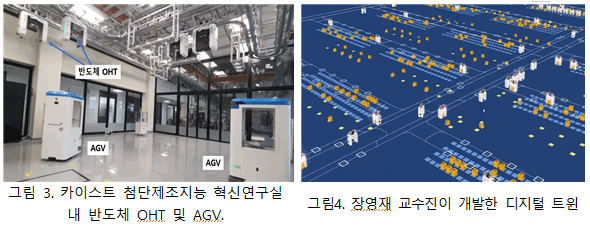

Industrial and Systems Engineering
Development and commercialization of large-scale automatic logistics system using digital twin and AI실험실 : https://www.sdm.kaist.ac.kr/
교원 창업기업 : (주) 다임리서치 (https://www.daimresearch.com)
연구내용
연구성과
□ Development of a large-scale swarm commercialization algorithm to control AMR
Professor Youngjae Jang's lab developed an algorithm for commercialization of large-scale fleet control (Massive Fleet Control) that controls hundreds to thousands of AMRs, and developed an AGV management system (AGV Management System – AMR) that can buid a related test bed and can be commercialized. Development and commercialization are in progress.
The core of this research is the development of an algorithm than can control a large-scale swarm and a system that can be used in actual industry. There are two main purposes of AMR.
1) Job Allocation, which matches ARM and tasks, and 2) Path Planning, which searches for the optimal driving route. And such work assignment and route navigation must be continuously updated or changeable based on real-time information. In particular, we are developing a general-purpose algorithm that can be applied to various types of AMR using Deep-Reinforcement Learning, one of the fields of AI.

Figure 1. AGVs in logistic system, Figure 2. AGVs used in Audi factories
□ AGV driving empirical study
Professor Youngjae Jang's research team opened the <Advanced Manufacturing Intelligence Innovation Center> (Figure 3), equipped with AGVs and automatic logistics equipment used in actual semiconductor factories, last year and has extracted relevant data from actual industrial equipment and has verified algorithms at actual industrial sites. Research on its use is in progress. By combining digital twin technology, which was selected as one of the <KAIST Top 10 Technologies> in 2019, with AI technology, we have completed an empirical study on the operation of more than 500 AGVs and are currently commercializing it (Figure 4).
By linking with the PC/PLC of the equipment, the actual physical system is implemented in real time in a virtual environment through IoT sensors, and this is structured to make optimal decisions by linking with AI and a simulator (Figure 5).

Figure 3. Semiconductor OHT and AGV in KAIST Advanced Manufacturing Intelligence Innovation Lab
Figure 4. Digital Twin developed by Professor Youngjae Jang Team
□ Automatic identification of abnormal signs in AGV(Using Deep AutoEncoder)
Anomaly reading technology using Deep AutoEncoder, which automatically determines abnormal signs in AGVs, is in the commercialization stage. This technology has been selected for 3 patents and 2021 Research Foundation mid-career research, and is being supported with 300 million won per year, and has already successfully transferred more than 100 million won worth of technology. In order to commercialize this technology, we have established <Dime Research>, a research institute invested by KAIST, and are in the process of commercializing it. Dime Research is already realizing technology commercialization by signing related solution contracts with global companies such as LG Electronics, Samsung Electro-Mechanics, and Synustech.

Figure 5. Digital Twin Configuration (Physical system is linked with virtual system and supports for Simulator-AI decision making)
Figure6: Abnormal symptom identification system using Auto Encoder developed by Daim Research.
